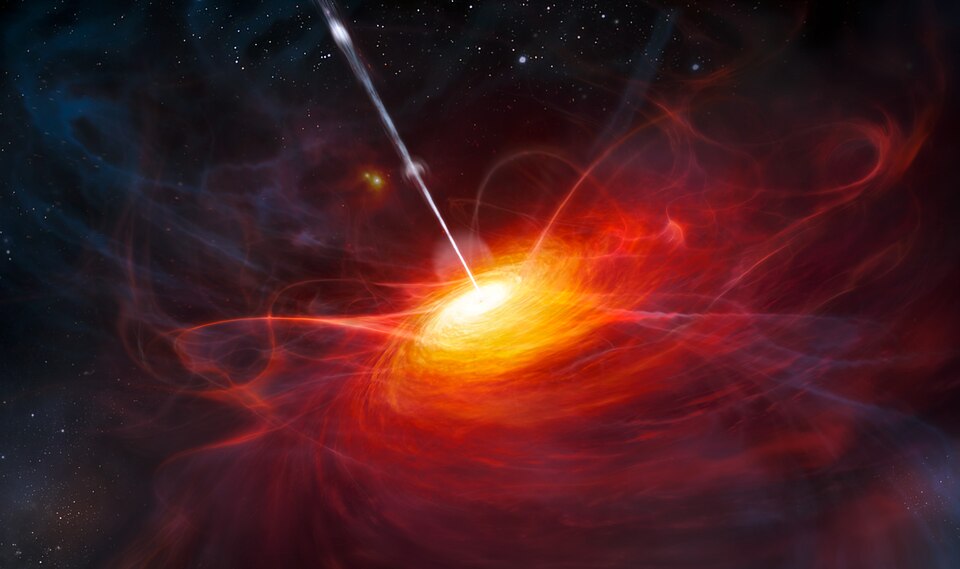
What is a quasar? A quasar is a very bright energy source at the center of a young, newly formed galaxy. All of the quasars we can see are incredibly far away from us.
The word quasar is the shortened form of quasi-stellar radio source and they were named by an astrophysicist called Hong-Yee Chiu in 1964.
Quasars are found at the center of galaxies and they are basically supermassive black holes. Over a million quasars have been identified so far. They are relatively easy to see because they are incredibly bright. They are some of the most luminous objects in the universe. A quasar is not just a little bit brighter than a star, a quasar is brighter than an entire galaxy. A quasar puts out more light than our entire Milky Way galaxy. To put it another way, the closest quasar to us is about 27 trillion times brighter than our sun. There are lots of different quasars and the largest could be 100,000 times brighter than the Milky Way. Where does all this light come from?
The easiest way to understand a quasar is to think about the water going down the drain in your bath when you pull out the plug. There is a lot of water trying to get through a small and narrow entrance. All of the water cannot get through at once, so the water piles up and starts to rotate creating a vortex. This is what happens with a quasar. A black hole is an area of space where the gravity is so great that it pulls in anything that crosses its event horizon. This is like the plug. The problem with the supermassive black hole is that its gravity is supermassive and it sucks in far more material than can fit through the plug. This material backs up and forms a swirling vortex above the black hole, just like the water swirling down your plug in the bath.
Quasars form at the center of very young galaxies. Every galaxy in the universe has a black hole at the center of it. Whether the galaxy formed first and then the black hole appeared or whether the black hole was there and the galaxy formed around it is not known. Whatever the reason, every galaxy has a black hole at the center of it. Depending on the size of the material that will coalesce into the galaxy, the black hole could be a supermassive black hole. So, what makes a quasar so incredibly bright?
The reason a quasar is so bright is because of heat produced by friction. A galaxy forms out of a huge quantity of dust and gas. Most of it is hydrogen because that is the most common element in the universe. Gravity starts to pull all of the material and it accumulates at the center. The supermassive black hole is at the center of this mass of dust and hydrogen and it starts to attract it. As the dust and gas is pulled in, it starts to spin around the black hole. Remember our bathplug analogy? The dust spins and the closer it is to the black hole, the faster it spins. Right down by the black hole the dust and gas spins at ferocious speeds, sometimes getting to 80% of the speed of light. At this speed, the gas molecules and dust particles collide with each other and this friction produces a lot of heat. This heat can reach temperatures of 40 trillion degrees, which isn’t a temperature I can remotely begin to imagine. This heat also produces a lot of light, which is where the incredible brightness of the quasars comes from.
Quasars continue to shine for as long as there is material to feed their black hole. Once the dust and gas runs out, they just fade away until there is only the supermassive black hole left. They can relight if the black hole happens to run into a new galaxy and it gets more fuel. Quasars are only found in young galaxies and it is thought that all galaxies went through a quasar phase. The dust and gas in young galaxies is very dense and very close to the black hole. As the black hole eats through the matter and the quasar forms, it consumes all of the matter that is near to it. Once this has been used up, it fades away and leaves the rest of the matter which is orbiting the black hole but too far away to be pulled in. This could be what gives galaxies their orbital speed. Our Milky Way Galaxy could have had a quasar at some point. And this is what I learned today.
Sources
https://esahubble.org/wordbank/quasar
https://en.wikipedia.org/wiki/Quasar
https://www.space.com/17262-quasar-definition.html
https://www.popularmechanics.com/space/deep-space/a20351/quasar-temperature
Image By ESO/M. Kornmesser – http://www.eso.org/public/images/eso1122a/, CC BY 4.0, https://commons.wikimedia.org/w/index.php?curid=15700804
